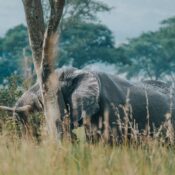Forest Duiker (Cephalophus subspecies)
Forest Duiker (Cephalophus subspecies)
Forest Duiker (Cephalophus subspecies)

Yellow-backed duiker (Cephalophus sylviculter)
The striking yellow-backed duiker (Cephalophus sylviculter) is also atypical of the family, owing to its relatively large size — heavier than a bushbuck — rather than any habitat preference.
The coat of yellow-backed duikers is black or brown in color with a yellow triangular patch near the tail. This yellow patch typically will not appear until about 1 month of age and will not be completely developed until about 10 months. Males and females resemble each other in appearance, although females are slightly larger. The muzzle area is a light gray color which surrounds their white lips. Both sexes have short, conical horns that grow between 8.5 and 21 centimeters long.
Young yellow-backed duikers are born a dark brown color with spotted flanks and red undersides. These cryptic colors help them remain hidden from predators in the forest.
Yellow-backed duikers have unique scent glands located posterior to each eye. Unlike other antelope species, these glands secrete from a grouping of pores, not from a solitary large opening. These scent glands are used to mark territorial boundaries. Yellow-backed duikers are built for life in dense vegetation. The body is arched, with short forelegs and longer hindlegs for manuverability.
Yellow-backed duikers are one of the largest species of forest duikers, ranging from 45 to 80 kilograms in the wild. The body is 115 to 145 centimeters in length, with a short tail measuring 11 to 18 centimeters. Yellow-backed duikers have the largest brain size relative to body size than any other antelope species.
It is a west African species, but has been recorded in several forests in western Uganda, including those in Bwindi Impenetrable Forest, Mgahinga, Rwenzori and Queen Elizabeth national parks; it’s sometimes encountered fleetingly along the forest track leading uphill from the Buhoma headquarters at Bwindi.

Of the more typical duiker species, Harvey’s red duiker (C. harveyi) is a tiny chestnut-brown antelope found in forested parts of Queen Elizabeth National Park and in the Kibale Forest.

The blue duiker (C. monticola), even smaller and with a grey-blue coat, is known to occur in Queen Elizabeth, Murchison Falls, Kibale and Bwindi national parks.

Peter’s duiker (C. callipygus) has been recorded in Bwindi, Kibale and Queen Elizabeth; the black-fronted duiker (C. nigrifions) in Mgahinga and Bwindi; and there have been unconfirmed sightings of the white-bellied duiker (C. leucogaster) for Bwindi and Semliki.

The red-flanked duiker (C. rufilatus) and Weyn’s duiker (C. weynsi) have not been recorder in any national park, but they most probably occur in the Budongo Forest.
For more information visit
All Categories
Recent Posts
Kidepo Valley National Park
The Kabaka’s lake
What is the African elephant?
Tags
Quick booking process
+256 393254072


